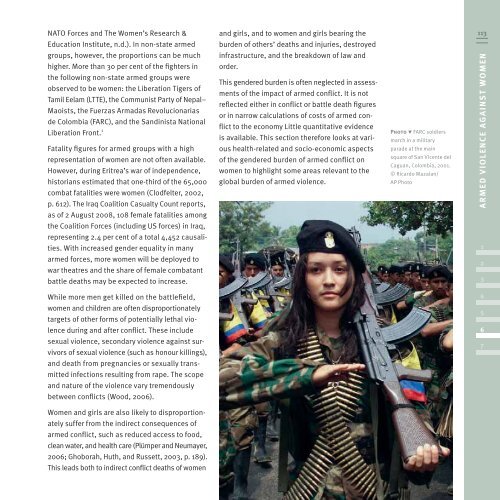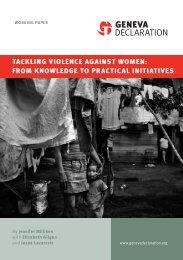Global Burden of Armed Violence - The Geneva Declaration on ...
Global Burden of Armed Violence - The Geneva Declaration on ...
Global Burden of Armed Violence - The Geneva Declaration on ...
Create successful ePaper yourself
Turn your PDF publications into a flip-book with our unique Google optimized e-Paper software.
NATO Forces and <str<strong>on</strong>g>The</str<strong>on</strong>g> Women’s Research &<br />
Educati<strong>on</strong> Institute, n.d.). In n<strong>on</strong>-state armed<br />
groups, however, the proporti<strong>on</strong>s can be much<br />
higher. More than 30 per cent <str<strong>on</strong>g>of</str<strong>on</strong>g> the fighters in<br />
the following n<strong>on</strong>-state armed groups were<br />
observed to be women: the Liberati<strong>on</strong> Tigers <str<strong>on</strong>g>of</str<strong>on</strong>g><br />
Tamil Eelam (LTTE), the Communist Party <str<strong>on</strong>g>of</str<strong>on</strong>g> Nepal–<br />
Maoists, the Fuerzas Armadas Revoluci<strong>on</strong>arias<br />
de Colombia (FARC), and the Sandinista Nati<strong>on</strong>al<br />
Liberati<strong>on</strong> Fr<strong>on</strong>t. 1<br />
Fatality figures for armed groups with a high<br />
representati<strong>on</strong> <str<strong>on</strong>g>of</str<strong>on</strong>g> women are not <str<strong>on</strong>g>of</str<strong>on</strong>g>ten available.<br />
However, during Eritrea’s war <str<strong>on</strong>g>of</str<strong>on</strong>g> independence,<br />
historians estimated that <strong>on</strong>e-third <str<strong>on</strong>g>of</str<strong>on</strong>g> the 65,000<br />
combat fatalities were women (Clodfelter, 2002,<br />
p. 612). <str<strong>on</strong>g>The</str<strong>on</strong>g> Iraq Coaliti<strong>on</strong> Casualty Count reports,<br />
as <str<strong>on</strong>g>of</str<strong>on</strong>g> 2 August 2008, 108 female fatalities am<strong>on</strong>g<br />
the Coaliti<strong>on</strong> Forces (including US forces) in Iraq,<br />
representing 2.4 per cent <str<strong>on</strong>g>of</str<strong>on</strong>g> a total 4,452 causali-<br />
ties. With increased gender equality in many<br />
armed forces, more women will be deployed to<br />
war theatres and the share <str<strong>on</strong>g>of</str<strong>on</strong>g> female combatant<br />
battle deaths may be expected to increase.<br />
While more men get killed <strong>on</strong> the battlefield,<br />
women and children are <str<strong>on</strong>g>of</str<strong>on</strong>g>ten disproporti<strong>on</strong>ately<br />
targets <str<strong>on</strong>g>of</str<strong>on</strong>g> other forms <str<strong>on</strong>g>of</str<strong>on</strong>g> potentially lethal vio-<br />
lence during and after c<strong>on</strong>flict. <str<strong>on</strong>g>The</str<strong>on</strong>g>se include<br />
sexual violence, sec<strong>on</strong>dary violence against sur-<br />
vivors <str<strong>on</strong>g>of</str<strong>on</strong>g> sexual violence (such as h<strong>on</strong>our killings),<br />
and death from pregnancies or sexually trans-<br />
mitted infecti<strong>on</strong>s resulting from rape. <str<strong>on</strong>g>The</str<strong>on</strong>g> scope<br />
and nature <str<strong>on</strong>g>of</str<strong>on</strong>g> the violence vary tremendously<br />
between c<strong>on</strong>flicts (Wood, 2006).<br />
Women and girls are also likely to disproporti<strong>on</strong>-<br />
ately suffer from the indirect c<strong>on</strong>sequences <str<strong>on</strong>g>of</str<strong>on</strong>g><br />
armed c<strong>on</strong>flict, such as reduced access to food,<br />
clean water, and health care (Plümper and Neumayer,<br />
2006; Ghoborah, Huth, and Russett, 2003, p. 189).<br />
This leads both to indirect c<strong>on</strong>flict deaths <str<strong>on</strong>g>of</str<strong>on</strong>g> women<br />
and girls, and to women and girls bearing the<br />
burden <str<strong>on</strong>g>of</str<strong>on</strong>g> others’ deaths and injuries, destroyed<br />
infrastructure, and the breakdown <str<strong>on</strong>g>of</str<strong>on</strong>g> law and<br />
order.<br />
This gendered burden is <str<strong>on</strong>g>of</str<strong>on</strong>g>ten neglected in assess-<br />
ments <str<strong>on</strong>g>of</str<strong>on</strong>g> the impact <str<strong>on</strong>g>of</str<strong>on</strong>g> armed c<strong>on</strong>flict. It is not<br />
reflected either in c<strong>on</strong>flict or battle death figures<br />
or in narrow calculati<strong>on</strong>s <str<strong>on</strong>g>of</str<strong>on</strong>g> costs <str<strong>on</strong>g>of</str<strong>on</strong>g> armed c<strong>on</strong>-<br />
flict to the ec<strong>on</strong>omy Little quantitative evidence<br />
is available. This secti<strong>on</strong> therefore looks at vari-<br />
ous health-related and socio-ec<strong>on</strong>omic aspects<br />
<str<strong>on</strong>g>of</str<strong>on</strong>g> the gendered burden <str<strong>on</strong>g>of</str<strong>on</strong>g> armed c<strong>on</strong>flict <strong>on</strong><br />
women to highlight some areas relevant to the<br />
global burden <str<strong>on</strong>g>of</str<strong>on</strong>g> armed violence.<br />
Photo " FARC soldiers<br />
march in a military<br />
parade at the main<br />
square <str<strong>on</strong>g>of</str<strong>on</strong>g> San Vicente del<br />
Caguan, Colombia, 2001.<br />
© Ricardo Mazalan/<br />
AP Photo<br />
113<br />
A R M E D V I O L E N C E AG A I N S T WOMEN<br />
1<br />
2<br />
3<br />
4<br />
5<br />
6<br />
7









